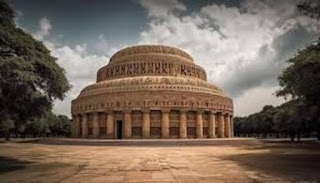Neo-Classical architecture in India represents a style that emerged during the colonial period, heavily influenced by Western classical architectural elements. This architectural style became popular in the late 19th and early 20th centuries, reflecting a fusion of Indian and European design principles. Today, many iconic buildings across India showcase the grandeur and elegance of Neo-Classical architecture, serving as a testament to the country's rich architectural heritage.
The
roots of Neo-Classical architecture
in India can be traced back to the British colonial rule, when European
architects and planners brought their design principles to the subcontinent.
The style draws heavily from the classical architecture of ancient Greece and Rome,
characterized by symmetrical proportions, columns, pediments, and other ornate
detailing. Neo-Classical architecture in India aimed to embody the ideals of
order, symmetry, and proportion, reflecting the grandeur and power of the
British Empire.
In
India, Neo-Classical architecture can be seen in a variety of structures,
including government buildings, palaces, museums, and educational institutions.
Some of the most notable examples of Neo-Classical architecture in India
include the Victoria Memorial in Kolkata, the Gateway of India in Mumbai, and
the Rashtrapati Bhavan in New Delhi. These buildings feature grand facades,
towering columns, and elaborate detailing, showcasing the architectural prowess
of the colonial era.
Neo-Classical
architecture in India is characterized by its emphasis on symmetry, proportion,
and classical ornamentation. Buildings in this style often feature grand
entrances with columns, pediments, and decorative elements such as friezes and
cornices. The use of classical orders, such as Doric, Ionic, and Corinthian
columns, adds a sense of grandeur and timelessness to these structures.
One of
the key uses of Neo-Classical architecture in India was to convey a sense of
power, authority, and permanence. Government buildings, palaces, and
institutions built in this style were intended to showcase the might and
influence of the colonial rulers. The imposing facades and grand interiors of
Neo-Classical buildings served as symbols of imperial power and control,
leaving a lasting impression on the landscape of Indian cities.
Today,
many Neo-Classical buildings in India stand as symbols of the country's
colonial past and architectural heritage. While some of these structures have
been well-preserved and maintained, others have fallen into disrepair or faced
threats of demolition. Efforts are being made to preserve and protect these
architectural treasures, recognizing their historical significance and cultural
value.
In
conclusion, Neo-Classical
architecture in India represents a unique blend of Indian and Western design
influences, reflecting the country's colonial history and cultural exchange.
The grandeur and elegance of Neo-Classical buildings continue to capture the
imagination of architecture enthusiasts and visitors alike, standing as
testaments to the craftsmanship and vision of the architects who created them.
As these iconic structures endure the test of time, they serve as reminders of
India's rich architectural legacy and the enduring impact of colonial rule on
the country's built environment.
